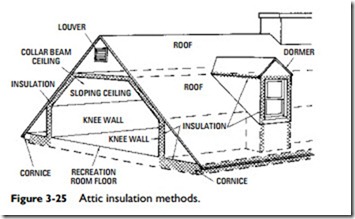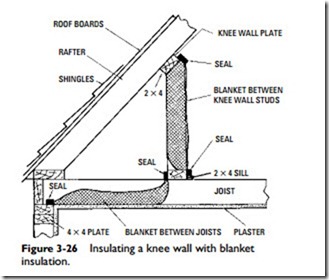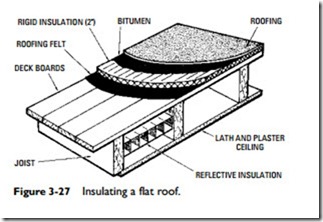Insulating Attics, Attic Crawl Spaces, and Flat Roofs
Most houses and many other structures are constructed with an attic or attic crawl space between the roof and the ceiling of the top floor. Unless this space is properly insulated and ventilated, it will produce the following two problems:
1. Condensed moisture formation
2. Excessive heat loss or gain
During the winter months, the heat from the occupied lower spaces moves upward (because warm air is lighter) into the cooler attic or attic crawl space. As it moves, the heat follows a number of different pathways, including:
1. Through poorly insulated ceilings
2. Around cracks in attic stairway doors or attic pulldown stair- ways
3. Through ceiling fixture holes
4. Along plumbing vents and pipes
5. Along air ducts
6. Through air spaces within interior partitions
Each of these pathways for heat transmission can be blocked by insulation. Typical attic insulation methods are illustrated in Figure 3-25. Attic door cracks can be blocked with weather stripping. Pipe, duct, vent, and fixture holes can be sealed off by stuffing them with loose insulation torn from batts or blankets.
The ceiling of the top floor should be covered with a minimum of 6 in of suitable insulation material to be properly effective in reducing the heat loss from the occupied spaces during the winter months or the heat gain during the summer. This can be installed during the initial construction stages of a new house or building, or it can be added to the attic floor surface of an existing structure. Sealing or filling the air spaces within interior partitions is relatively easy to do in new construction. An existing structure presents a more difficult problem that generally requires considerable experience in installing insulation materials.
Sometimes a half-wall (a knee wall) is installed between the attic floor and the roof. This is most commonly insulated with blanket insulation, as illustrated in Figure 3-26.
The condensation of moisture in the attic or attic crawl space is caused by the moisture in the warm air rising from the lower occupied spaces. This moisture comes in contact with the colder air of the attic, condenses, and causes the insulation and other building materials to become damp. In time, this dampness will have a dam- aging effect. Ventilation is an effective method of reducing or eliminating condensation in attics and attic crawl spaces. The air enters and leaves through vents placed in the gables and cornices. The size of the vents will be determined by the area being ventilated.
A flat roof can be effectively insulated by installing 2-in-thick rigid insulation board before the roofing material is applied. Roofing felt should be placed between the bare wood boards of the roof deck and the insulation. Additional insulation is placed under the deck boards (i.e., between the deck boards and the ceiling of the room below). (See Figure 3-27.)


